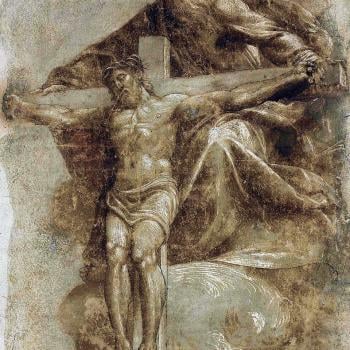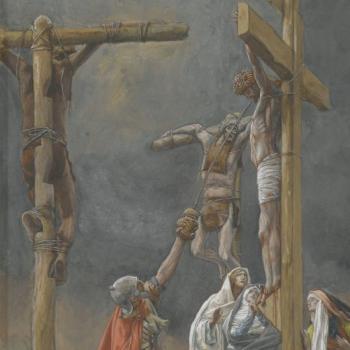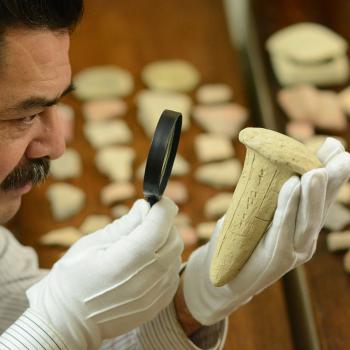
Hebrews 1:4-2:4 compares Jesus and angels, and Jesus comes out on top. Just when you think there are no more comparisons left to make between Jesus and angels, the author of the Epistle makes one more, as recorded in chapter 2: Jesus even comes out on top when he is at the bottom of the pit. Here’s what the author of this letter to the Hebrew Christians writes, “But we see him who for a little while was made lower than the angels, namely Jesus, crowned with glory and honor because of the suffering of death, so that by the grace of God he might taste death for everyone” (Hebrews 2:9; ESV). Jesus is crowned with glory and honor because he suffered/tasted death for everyone. Now no angel ever did that for the world, which by the way includes you and me! One way to summarize the message of Hebrews would be like this: Jesus descends to the depths to take us to the heights. Take hold in faith and rise!
Before proceeding further, let’s give an overview of the comparisons between Jesus and the angels set forth in Hebrews chapters one and two:
-
Jesus has become superior to the angels. Jesus’ name that he has inherited is more excellent than theirs (Hebrews 1:4).
-
Jesus is God’s firstborn Son whom the angels worship (Hebrews 1:5-6).
-
Jesus is eternal and the angels are ephemeral (like the wind and fire’s flame) (Hebrews 1:7-9).
-
Jesus is the sovereign Savior whom the angels serve. Jesus sits at God’s right hand from whom the angels are sent to serve those whom he has saved (Hebrews 1:13-14).
-
The message declared through angels was true (not fake news) and disobedience came with a penalty. How much more severe will be the judgment for those who neglect the message of salvation through Jesus (Hebrews 2:2-3).
-
The world to come is subject to Jesus, who was subjected to severe suffering and a humiliating death to save and exalt us. The angels never stooped so low or rise so high (Hebrews 2:5-9).
The comparisons from chapter 1:4-2:4 deal largely if not exclusively with Jesus’ supreme glory. The comparison in chapter 2:5 and following deals largely if not exclusively with Jesus’ ultimate humility. Jesus’ greatness is set forth both in terms of being higher than the angels and lower than the angels.
We need to stop at this point. There was a problem, namely with the lower aspect of the comparative judgments. The Hebrew Christians had gotten hung up on the “lower” aspect and were having a hard time ascending with Jesus. Who could blame them? The world at present looks nothing like Jesus is holding the whole world in his hands. Nor did Jesus look the part of Lord while suffering here below. Chapter one is a great message for Sunday morning when we’re seated in the heavenly sanctuary, but not for the rest of the week when we are back on Golgotha!
The author of this epistle acknowledges this church’s questions. In fact, he plants himself right next to them in writing “we.” Like a good pastor, the author writers empathically, “At present, we do not yet see everything in subjection to him” (Hebrews 2:8; ESV). As Thomas G. Long poignantly puts it in his commentary,
Every congregation knows well what the Preacher means. Look at the world around us, and it hardly seems that the Son of God is running the show. From the hole in the ozone to the torn fabric of society to the broken places in the human heart, all creation seems under the sway of tragic evil. The Preacher is telling the truth; far from being under the control of the victorious Son, the world looks chaotically out of control (Thomas G. Long, Hebrews, Interpretation: A Bible Commentary for Teaching and Preaching {Louisville: Westminster/John Knox Press, 1997}, page 37).
But as Long also notes, the writer of Hebrews builds suspense centered on the name of Jesus. He does so to dramatic effect. Long points out that such suspenseful, dramatic effect centering on the name Jesus is found every time the name is used—2:9; 3:1; 6:20; 7:22; 10:19; 12:2; 12:24; 13:20 (See Long, page 37). The ESV brings this emphasis out well here: “But we see him who for a little while was made lower than the angels, namely Jesus” (Hebrews 2:9). Who do we see who was made lower? Jesus. We see with our naked eye the one who has suffered and died— Jesus. We must also see him as exalted with the eye of faith. As the rest of Hebrews and New Testament makes clear, what we see by faith now will someday become sight—Jesus exalted at the right hand of God!
The writer of Hebrews seeks to show his readers throughout his epistle why it was crucial that Jesus suffered death like a lowly lamb of sacrifice, and why even here he is greater than the angels: what angel(s) ever suffered humiliating death for you? Such love, especially given that it was God’s firstborn Son who made the humbling descent in order to save and exalt you!
The church’s time of exaltation still awaits them. Just as Jesus had to go through his hour of trial, so would they. They could take great comfort in knowing that they were not alone, and that they were made participants in Jesus’ life, as well as are surrounded by a great cloud of witnesses who had run well the race of faith before them and who will enter the promised rest with them:
Therefore, since we are surrounded by so great a cloud of witnesses, let us also lay aside every weight, and sin which clings so closely, and let us run with endurance the race that is set before us, looking to Jesus, the founder and perfecter of our faith, who for the joy that was set before him endured the cross, despising the shame, and is seated at the right hand of the throne of God. Consider him who endured from sinners such hostility against himself, so that you may not grow weary or fainthearted. In your struggle against sin you have not yet resisted to the point of shedding your blood (Hebrews 12:1-4; ESV).
While the church to which the author of Hebrews writes did not see Jesus with the naked eye reigning supreme, the writer declares that they will see it when Jesus exposes all hearts and lives before God’s throne in judgment (See for example Hebrews 9:27). He encourages them to wipe away their tears and doubts and look anew with the eye of faith.
While we do not yet see everything as subject to Jesus, we do see him (Hebrews 2:8-9). We see Jesus! We see what Jesus has done for us in humbling himself and being made perfect vocationally through his suffering (Hebrews 2:10) so that he could be a faithful, merciful high priest on our behalf (Hebrews 2:17-18). He conquered and destroyed the Devil and his power over death to help us, not angels (Hebrews 2:14-16):
Since therefore the children share in flesh and blood, he himself likewise partook of the same things, that through death he might destroy the one who has the power of death, that is, the devil, and deliver all those who through fear of death were subject to lifelong slavery. For surely it is not angels that he helps, but he helps the offspring of Abraham. Therefore he had to be made like his brothers in every respect, so that he might become a merciful and faithful high priest in the service of God, to make propitiation for the sins of the people. For because he himself has suffered when tempted, he is able to help those who are being tempted (Hebrews 2:14-18; ESV).
Now we see with the eye of faith through hearing God’s Word. Then we shall see face to face. Remember: it’s never over at halftime.
Today is Super Bowl Sunday. Who knows how it will turn out? One can never call the game at halftime of a big game, just like with life. That is how a pastor once encouraged me regarding struggles in my life. This is how the writer of Hebrews encourages his readers past and present. I believe that this is how my fellow residents from various countries at Overseas Ministries Study Center in New Haven, Connecticut and I will encourage one another as we study this passage a week from now: it’s never over at halftime.
As my fellow residents at OMSC share about suffering and persecution in their countries, they encourage me. Though they do not discount the reality of the suffering church that they see in the lands where they come from and to which they go, they also see with a clear eye of faith: they see Jesus. These believers know this Jesus who was made a little lower than the angels and suffered unto death and who now reigns supreme for them. As one of these missionaries from another land said recently in meditating on this passage, we are participants in Jesus’ life! This is his hope and comfort every day of his life.
What is our hope and comfort that will keep us going at halftime and beyond? Jesus descends to the depths to take us to the heights. Take hold in faith and rise!












